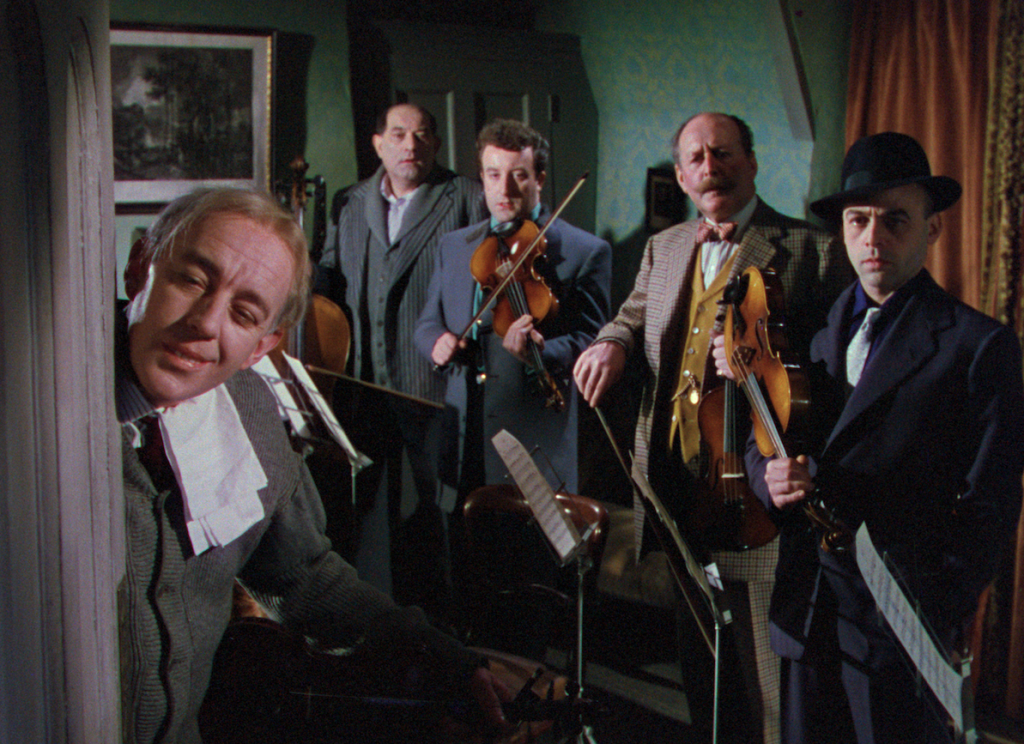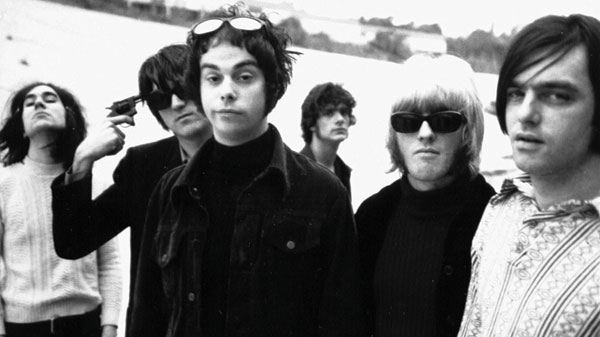This Ealing Studios classic is a subversive and macabre slow-burn comedy, in which a cast of quirky characters undertake a bank heist. The band of thieves led by Professor Marcus (Alec Guinness) pose as a string quintet to rent a room from an elderly widow, Mrs Wilberforce, who, unbeknownst to them, has a habit of reporting suspicious behaviour to the police.
The robbery is a success, but the thieves, panicked by Mrs Wilberforce’s eventual discovery of their crime, go on to double-cross one another, with disastrous results.
As director Alexander Mackendrick acknowledged years later, The Ladykillers is ‘obviously a parody of Britain in its subsidence’. Mrs Wilberforce seems to be an embodiment of Victorian values and ideas, and her cluttered old house a reflection of crumbling post-war England.
The film was selected by Jack Morrison. Jack was the first stage manager at the Globe Theatre, and has worked across Cornwall for Kneehigh, the Eden Project and The Works, but is perhaps best known for his role supporting artists as project manager at Cornish funding body FEAST.
JACK MORRISON: INTRODUCTION
This was not my first selection for a film to present tonight. I had to work on my list with Cat from CAST, who was able to advise when a film had been screened here before, when a film might be unsuitable, or when my passion for a three-hour black and white French film about Commedia d’ell Arte, involving long lingering shots of a naked person in a barrel of water, might miss its audience here in Helston.
I have selected The Ladykillers, the 1955 British black comedy crime film directed by Alexander Mackendrick, made by Ealing Studios.
There is not enough time to talk about what this film means to me, but I have done my best to cut it down and bring these themes together.
This film is a look at post-war 1955 London, a London of rationing, bomb sites, a city that has had nine years of recovery, a city with an unknown future.
While Ealing could have made a bright funny slapstick film of dark British manners, The Ladykillers is much more of a study of post-war pathos, a kind of mourning for the world about to vanish.
Ealing Comedies of the 40s and 50s inhabit a relatively safe space in British Culture. They are from the studio that brought us George Formby and Gracie Fields.They can be portrayed as glorified Carry On films, with the smut wiped off.
In fact watch out for the on-screen fight between a Carry On Cleo cast member and an Up Pompeii cast member in the film.
But The LadyKillers is not a piece of light entertainment.
It is a tightly paced, tense, dark, funny, pathos-ridden pot boiler. A heist that goes wrong and the unraveling of relationships with a mounting death toll.
The film we are about to watch is the ancestor of Reservoir Dogs.
There are reassuringly cosy moments of borderline nostalgia running through the piece. If the police look like the police from Dixon of Dock Green it is because they ARE the police from Dixon of Dock Green.
Despite this relative warmth, the apparent optimism of the post-war era, The Ladykillers gets to the inherent human fear of change. The characters are all trying to influence a future just out of sight, threatening to sweep them away. And each one of them carries a flavour of pathos. They are caught in a moment of nervous uncertainty, at the end of a big move and waiting for the next.
We never catch much of a glimpse of this future they are so afraid of. It is not speculated on. This film is more a look at the present of 1955 and a look back at the past that is disappearing. Like the rear view from a train carriage, we can see down the tracks where they have come from, but not where they are going. As the body count mounts up, we are left wondering who will be left to take advantage of the future and who will be carried away down the line.
The house in the film looms monolithic and immovable and also crumbling and vulnerable, as if its huge dark bulk is poised to fall onto the railway below and to be carried away by the London trains.
While we may remember the Ealing Comedies of this era as very specifically English films, looking at Britain from an English and even London-centric perspective, it’s good just to lift the lid on The Ladykillers team.
They are astonishing. I could speak at length about all of them.
The producer was Michael Balcon, from many Golden Age Ealing Comedies.
The cast member I am going to single out is Katie Johnson as Mrs. Wilberforce. She began acting in the theatre in 1894. In 1955 she was aged 76 and this role earned her a BAFTA.
She is the AK47 of little old ladies.
Watch her in this film, the way she is with the other actors, watch her absolutely go toe to toe, slugging it out with all of them.
There are moments that hinge on a look or a turn. She is giving us a masterclass in character acting, drawing on decades of experience.
She died less than two years after her BAFTA.
The American-Scottish writer William Rose also won a BAFTA and an Oscar nomination. He was born in Missouri, traveled to Canada in 1939 and volunteered to fight the Nazis. Throughout his life Rose received several Oscar nominations, actually winning in 1967 for Guess Who’s Coming to Dinner, a light comedy about inter-racial marriage, still outlawed in seventeen American states at the time of its release.
The Director, Alexander Mackendrick, also American-Scottish, born in Boston, was employed by the British Government Psychological Warfare Division and the Ministry of Information in World War 2. If The Ladykillers feels tense or uncomfortable it’s down to the dark psychological propaganda training of Mackendrick.
Cinematographer Otto Heller was born in Prague in 1896. He left Czechoslovakia in 1938 to escape Nazism and moved to Britain.
This quintessentially British film was created by a very international team. Perhaps this post-war international perspective makes it the most British film it can be.
Finally, the composer, Tristram Carey, was a pioneer of electronic and tape music. He co-founded Electronic Music Studios, created the first commercially available portable synthesiser and the EMS Synthi 100.
You will be familiar with this from Doctor Who and some Smashing Pumpkins albums.
No EMS Synthi 100, no Hedluv and Passman.
I know I had watched The Ladykillers three times by the time I was ten, twice at my grandparents’ house just outside London. This would have been just over twenty years after the film was made and even then my grandparents lived in a world we barely recognised.
It felt so long ago and it was so close, it’s like watching Mission Impossible 2 today, the same time difference.
My grandfather had served in the war, my grandmother was a fan of the doily and the antimacassar.
The clocks were wound on Sundays, tea at four and Ovaltine before bed. Homburg hat and Crombie coats on the hall stand, the near exoticism of the rag and bone man, shouting outside with his cart and skewbald horse.
This film was a window into the world my grandparents had come from, completely different from the 1970s and 80s I was experiencing.
I know what the house in The Ladykillers feels like. I taste the damp of the upstairs room, the temperature drop in the hallway, what it is to sleep in a neat bed of Army Surplus blankets and flannel sheets, the smell of that scullery where they do the washing up.
I know the unrivalled terror of a tea party with cup and saucer in one hand and a plate with cake in the other, trapped by crockery, and being asked to perform to a room of neat old ladies.
This film means a lot to me.
The pathos I feel is definitely linked to a world lost, but is layered through this film by an astonishing creative team.
Five years after this film the very steam locomotives that play such a huge and important part were themselves removed, swept away and replaced by diesel engines.
While my grandparents and their house are long gone I really hope you enjoy The Ladykillers as much as I did when I had hot-buttered toast, an Ovaltine to sip, and a blanket to hide behind, just in case.
Delivered on Thursday 20 and Friday 21 January, 2022.


